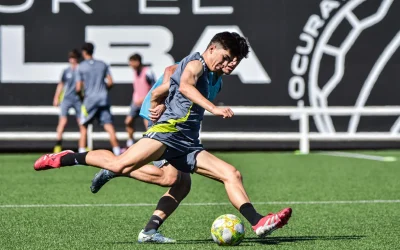1- 1st Division. EA League
In Spain, the most important football competition is La Liga, also known as EA League, the new sponsor for the 2023/2024 season. This competition features the best clubs in Spain, with Real Madrid and FC Barcelona as the main references. The competition is regulated by the Royal Spanish Football Federation, and the top four teams earn the reward of playing in Europe’s biggest competition: the Champions League. Teams that finish in fifth and sixth place qualify for the next edition of the Europa League, while the seventh-placed team qualifies for the Conference League.
It’s not all rewards though, as the bottom three teams face relegation to the Second Division, known as the Hypermotion League. However, in their first year in the Hypermotion League, they will receive significant financial support from the RFEF to help build a team with the goal of returning to Spain’s top football division.
As for the most successful teams in this competition, Real Madrid leads with 35 titles, followed by Barcelona with 27 titles in the 92 editions of the competition.
Regarding salaries, for the 2023/2024 season, the minimum wage in the EA League will be €186,000, but the vast majority of players will earn over €300,000 annually.
2- Second Division. Liga Hypermotion 2024/2025
Next comes the Second Division, the Hypermotion League, which consists of 22 teams. This competition is the second most important in Spain, as the teams that win it have the chance to be promoted to EA League. There are clubs with a rich history in this competition. Both Hypermotion League clubs and Liga EA clubs have large budgets and hold their training camps at top facilities in Spain or around the world.
For the 2023-2024 season, the top favorites to win the competition are the recently relegated teams, RCD Espanyol, Elche, and Valladolid, clubs with a long history in Spain’s first division that will try to make a quick return to the top tier. It won’t be easy, as only the top two teams will be directly promoted, while the teams finishing from third to sixth will compete in home-and-away playoffs, where only the champion will have the privilege of making it to the top. On the other hand, the four worst teams will be relegated to the limbo of professional Spanish football, the 1st RFEF.
Regarding salaries, wages in the Hypermotion League range from a minimum salary of €93,000 per year to figures close to €1 million for the highest-paying teams. Generally, the highest-paid players are the center-forwards.
3- Third Division – 1a RFEF
The third division, the 1st RFEF, is made up of two groups in Spain and is considered the last fully professional tier in Spanish football. This category includes historic clubs such as Málaga, Castellón, and Deportivo de la Coruña, which have significantly higher budgets compared to newly promoted teams. Nevertheless, each year brings surprises, and lower-budget clubs can make their way to the top.
The promotion system involves the top two teams from each group moving up directly to the Hypermotion League (Second Division). Teams finishing from second to fifth place in each group compete in playoffs to secure the third and final promotion spot. Conversely, the bottom four teams from each group are relegated to a semi-professional category, the 2nd RFEF. Players in the 1st RFEF typically have an average salary of around €50,000, though figures can range from €15,000 to €300,000 annually, depending on the strength of the team.

4- 2nd RFEF and 3rd RFEF
From this point, there are the 2nd RFEF and the 3rd RFEF, where teams are semi-professional. In many cases, football clubs organize trials to scout international talent. Additionally, some independent football trials are held in Spain, where numerous sporting directors and representation agencies gather to sign players for professional and semi-professional clubs.
The 2nd RFEF is structured into 6 groups across Spain, divided by regions, while the 3rd RFEF consists of 18 groups. The promotion system is the same for both categories: the top team from each group is promoted directly, while the teams finishing from second to fifth place in each group compete in playoffs to secure the remaining promotion spots. Players in the 2nd RFEF earn an average salary ranging from €15,000 to €50,000 annually, depending on the team’s objectives.
Beyond the 3rd RFEF, there are regional leagues not organized by the Royal Spanish Football Federation but by regional federations. In these categories, players are completely amateur. Players in the 3rd RFEF can earn from €3,000 up to €15,000 annually in top teams.
YOUTH CATEGORIES (16, 17, AND 18 YEARS OLD) IN SPAIN
Honor Division:
The highest youth category in Spain, where the best football academies are found. It is made up of 7 groups according to different regions. The top teams have the opportunity to compete in the Juvenile King’s Cup, which determines the best youth team of the year and represents the highest achievement for a club’s youth football program. Typically, this trophy is won by a club from EA League.
Nacional League:
This is the second tier at the national level. Like the Honor Division, it is also governed by the RFEF. In this category, there is one group per region, and only the top team earns promotion to the highest category. In the National League, the “B” teams of major Spanish clubs often play, typically fielding teams with mostly U16 players and even some players in the cadet age group.
Preferente League:
This category is organized by regional federations, and its competition structure depends on the number of licenses in each community, creating one, two, or even three groups per region to minimize long travel distances for the youth and reduce travel costs for the clubs. Despite this, the category is very attractive as it can serve as a stepping stone to national competitions.
Beyond the Preferente League, there are the 1st Division, 2nd Division, and 3rd Division, where the clubs are usually local and based in smaller towns within each territory.
CADET CATEGORIES (14 and 15 years old)
Honor Division:
Similar to the youth categories, the highest level of Spanish football for cadets is the Honor Division. However, unlike the youth categories, there are many more groups across Spain to make the category viable for clubs that are not among the most powerful. Typically, there is one group per autonomous community, similar to the National League for youth. In the cadet age group, all leagues are organized by the regional federations of the country.
Preferente:
In the cadet category, the second division is the Preferente, and there are several groups in each territory competing for promotion to the Honor Division. It is a very demanding category, as only the top team from each group is promoted to the Honor Division.
Similarly to the youth categories, beyond this level, there are the 1st Division and 2nd Division, which are very local in scope.
CHILDREN’S CATEGORIES (12 and 13 years old)
The structure of Spanish children’s football is exactly the same as the cadet structure, with a single Honor Division per region, representing the highest category for children. There is also the Preferente League, which includes several groups (the number depends on the licenses in each territory), where the champions can gain access to the Honor Division.
PRE-INFANTILE CATEGORIES (10 and 11 years old) AND MINOR CATEGORIES (8 and 9 years old)
In the younger age groups, Spanish football lacks a structured national system, and each autonomous community manages the competitions according to its own criteria. Additionally, there are many academies in Spain that do not compete in federation leagues, as they organize friendly matches independently among themselves.
CATEGORIES IN WOMEN’S FOOTBALL
Women’s football categories in Spain are more streamlined. The top tier of women’s football is the First Division (Superliga or Liga F), which features the best clubs in Spain, with FC Barcelona currently dominating women’s football. It is the only professional women’s football league in Spain. The top three teams in Liga F qualify for the premier European competition, the Champions League, while the bottom two teams are relegated to the second tier of Spanish football.
Historically, clubs such as RCD Espanyol, Rayo Vallecano, and Athletic Club have been pioneers in women’s football, but the last decade has seen a clear dominance by Barcelona. Other clubs like Real Madrid, Real Sociedad, and Atlético de Madrid have also heavily invested in women’s football and are improving their teams year after year. Below this level, there is the Primera División, which consists of a single group in Spain. The top two teams in this division are promoted to Liga F, while the bottom three teams are relegated to the second division. The second division features two groups across Spain, with the champions of each group earning promotion to Primera División. The two teams that finish in second place in their respective groups face a two-legged playoff to determine the final promotion spot. The bottom four teams are relegated to 1st Nacional, where there are six groups across Spain, and players generally do not receive compensation. However, some clubs offer tryouts for women who want to make the leap to Spain.

Beyond this, there are competitions regulated by regional federations in each territory.
In youth football, unlike men’s football, there are no national categories due to the smaller number of licenses, and everything is also managed by regional federations.
We hope this article has helped you better understand the organization of football competitions in Spain. If you want to learn more about regional tournaments, feel free to contact us for more information! Keep enjoying Spanish football!




